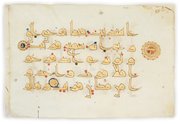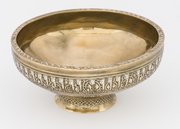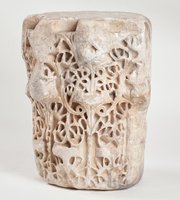
Fragment of a Tile Panel
Museum of Islamic Art
- Title:
- Fragment of a Tile Panel
- Production place:
- Central Asia
- Date:
- 1417
- Period:
- Timurid
- Title:
- Fragment of a Tile Panel
- Production place:
- Central Asia
- Date:
- 1417
- Period:
- Timurid
- Material:
- Fritware, Glaze
- Technique:
- Mosaic, Glazing
- Dimensions:
- 51 × 44 × 5.3 cm
This richly decorated tile fragment - composed of a mosaic of tiny fragments cut to fit together - would originally have appeared on the wall of a public building. Its ornamentation consists of a vivid pattern of intertwined floral blossoms and palmettes tessellating across the surface.
This type of mosaic tile decoration is highly typical of the Timurid period in Central Asia and Iran. This era was celebrated for its artistic flourishing, including ceramics. Timurid tile workers developed many new techniques for their craft, including cuerda seca, overglaze enamelling, and underglaze painted relief tiles in addition to the mosaic work as seen in this panel. Although mosaic tiles were time-consuming - requiring each piece to be individually cut and fired - the final effect was a riot of glorious colour, since each tiny piece could be fired at the perfect temperature for its individual glaze. The resulting rich palette, shown to greatest effect on public monuments almost entirely covered in the mosaic tiles, more than compensated for the time-consuming process.



